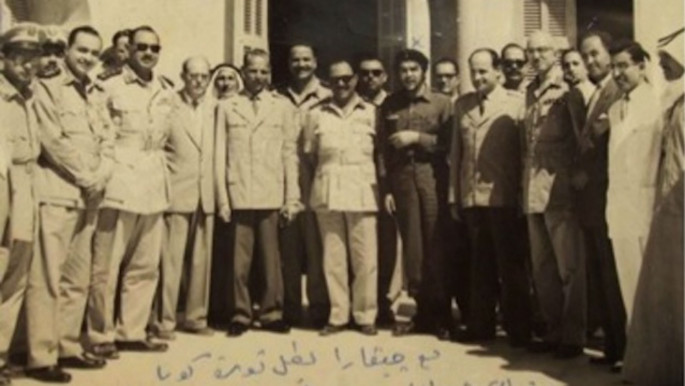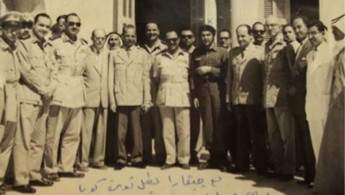When Che Guevara came to Gaza
Since the explicit Israeli colonisation of historic Palestine in 1948 supported by colonialist and imperialist powers, namely Britain and the US, the Palestinian struggle has become a global cause. Resistance was a natural response to the invasions and incursions better known as "the ethnic cleansing of Palestine".
Even before then, as the military occupation entrenched itself at the hands of pre-state Zionist militias and paramilitary units, massacres and forceful expulsion were committed, leading to the 1948 Nakba, the catastrophe, of the loss of the Palestinians' homeland. The 1967 Naksa, or "set back", followed with the defeat of Arab armies.
Displaced indigenous Palestinians were forced to live in refugee camps in makeshift tent cities in Gaza, the West Bank, Lebanon, Syria and Jordan, relying on food hand-outs provided by UNRWA.
At first they assumed that they would one day return to where they had been driven out by force. During the Nakba, some 500 towns and villages were wiped off the map as they were looted. Today, 70 years later, the displaced and dispossessed are still waiting for the implementation of that dream - "the right of return".
Amid all the developments at the time, a sense of revolt began to emerge among Palestinians to defend their land.
"Fedaeyyeen" - the Arabic term for "freedom fighters" - began to assemble and carry out reprisal attacks against occupying Israeli forces. Some fighters infiltrated the security border fence from neighbouring Arab countries.
Horrendous massacres followed, most notably in 1953, 1955 and 1956, in which hundreds of Palestinians were killed at the command of Ariel Sharon, then a hawkish army general charged with uprooting the Fedaeyyeen and punishing the refugees for supporting them.
Revolutionary spirit in Egypt
Egypt, known then as "The United Arab Republic", had administered the Gaza Strip between 1948 and 1967 and lost dozens of its soldiers, police and security officers, especially in south Gaza's Khan Younis and Rafah towns during a triple-pronged offensive against Egyptian forces by Britain, France and Israel in 1956, following Nasser’s decision to nationalise the Suez Canal.
 |
The Palestinian movement drew inspiration from guerrillas in Latin America, Vietnam and Algeria |  |
The spirit of revolution was running high in Egypt under leader Gamal Abdel Nasser, the godfather of pan-Arabism, who was known for his anti-imperialist and anti-colonialist stance. Nasser, who dominated Arab politics and the imagination of the Arab masses at the time, extended an invitation to none other than Ernesto Che Guevara, the Latin American revolutionary, to visit Cairo.
It's not known if visiting Gaza was on Che's agenda, or if it was Nasser's idea. But the timing of the visit was of great importance for the Palestinian national movement which was comprised of Fedaeyyeen. The movement drew inspiration from guerrillas in Latin America, Vietnam and Algeria.
The ideology of the Palestinian Fedaeyyeen was mainly left-wing nationalist, socialist or communist, and their proclaimed purpose was to defeat Zionism and liberate Palestine through armed struggle to establish it as "a secular democratic state".
The idea of liberation gained momentum as Palestinians had never achieved any form of real national independence in their homeland, and a few years later, in 1964, the Palestine Liberation Organisation (PLO) was formed and led by Ahmad Shukeiri. Yasser Arafat became the PLO's chairman in 1969 until his death in 2004.
Che Guevara in Gaza
After accepting Nasser's invitation, Guevara was sent to the region by Cuba's Fidel Castro on a three-month tour of 14 countries. A one-day visit was dedicated to Gaza which was then under Egyptian rule. Guevara landed in Gaza wearing his dark military fatigues on 18 June 1959 after travelling about 450km from Cairo.
He received a hero's welcome from the Egyptian de facto governor of Gaza, General-Lieutenant Ahmad Salim, as well as from Palestinian officials and heads of municipalities and many ordinary people.
“With Guevara, hero of the Cuban Revolution, at the mansion of the Governor General, Lieutenant General Ahmad Salim.
Gaza, 1959.”
During his short visit, he toured several Palestinian refugee camps including Al-Buraij camp, where he was welcomed with chants from the Cuban revolution. Cuba went on to welcome the founding of the Palestine Liberation Organisation, making official contact with it in 1965.
One of Che's goals for the visit was to support Arab and Palestinian national liberation and revolutionary movements against western imperialism and colonisation.
Zulfiqar Swirjo, an official affiliated to the Popular Front for the Liberation of Palestine stated during a previous interview that his father was there during that historic visit that aimed to share Guevara's beliefs and revolutionary ideas with Gaza's fighters. They had wanted to put together a strategic plan for a popular struggle to fight the Israeli forces using guerrilla warfare tactics.
 |
Today, two-thirds of Gaza's two million inhabitants are refugees, ethnically cleansed from their original homes |  |
Gaza
The Gaza Strip is a small slice of the eastern coastline of the Mediterranean Sea in the southern part of historic Palestine, bordering Egypt to the south-west and Israel to the east and north. At 45km long and between 5 and 12km in width, it has a total area of just 365 square km - around the same size as the city of Bakersfield, California (pop. 380,000).
Today, two-thirds of Gaza's two million inhabitants are refugees, ethnically cleansed from their original homes.
According to Palestinian researcher Salman Abu Sitta, after Guevara's visit to Gaza, Cuba gave scholarships to Palestinian students, granted citizenship to stranded Palestinians and held many conferences in support of Palestine. And as Palestine has become a symbol of struggle against colonialism, it's no surprise that India's first prime minister and anti-British colonialist Jawaharlal Nehru also visited Gaza in 1960 and met with the United Nations Emergency Force (UNEF), whose presence was to protect the old armistice line between Israel and Egypt.
The Argentinean revolutionary leader was summarily executed by Bolivian forces in October 1967, nearly four months after the "six-day war", when Gaza was annexed from Egyptian control and came under total Israeli occupation.
Che became an icon of resistance, especially for leftist Palestinian resistance movements such as The Popular Front for the Liberation of Palestine, The Democratic Front for the Liberation of Palestine, and the Palestinian People's Party.
His legacy endures and, for many Palestinian activists, he remains a source of inspiration, as a popular icon of rebellion against imperialism, colonialism and military occupation.
Yousef al-Helou is a freelance Palestinian journalist.



